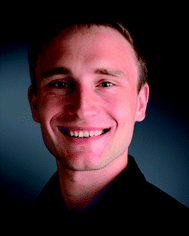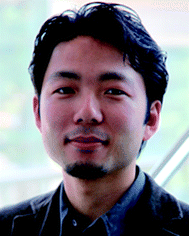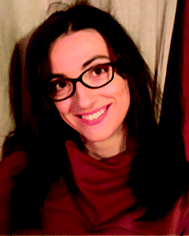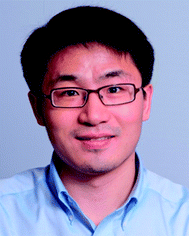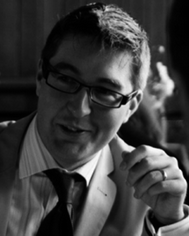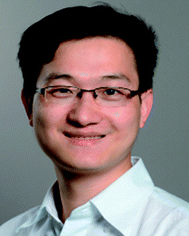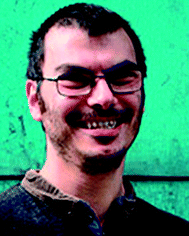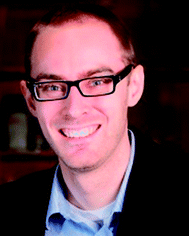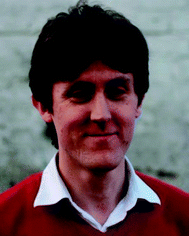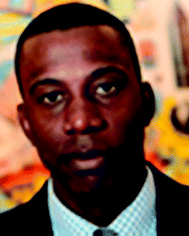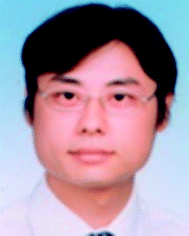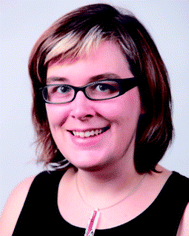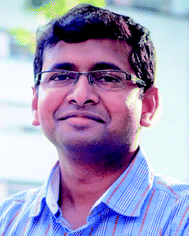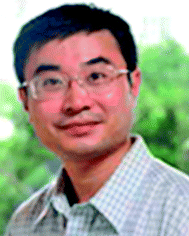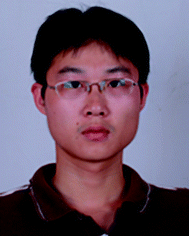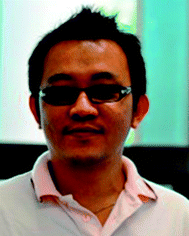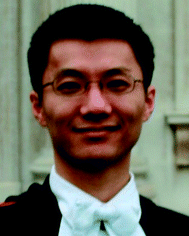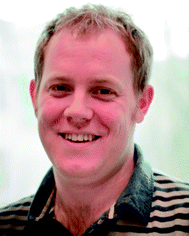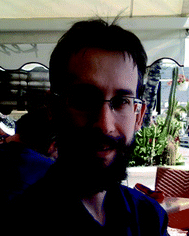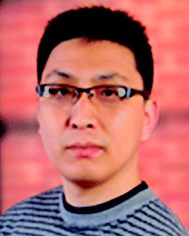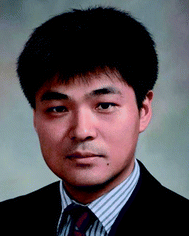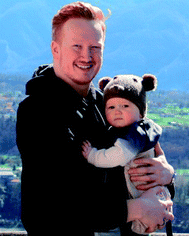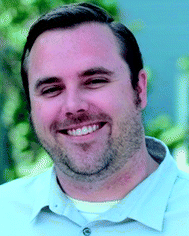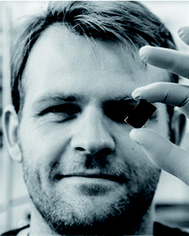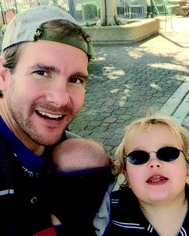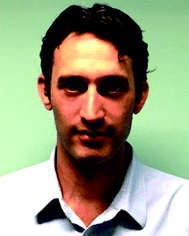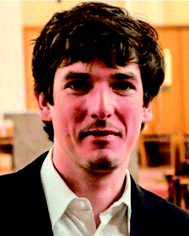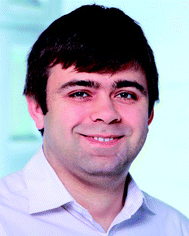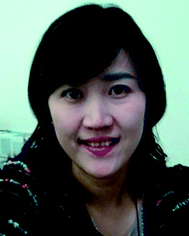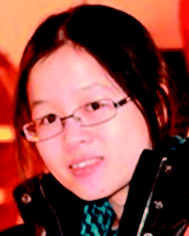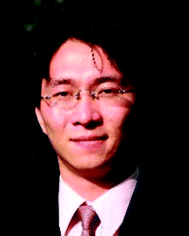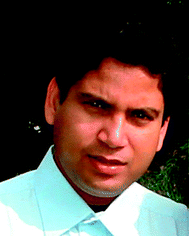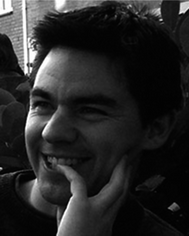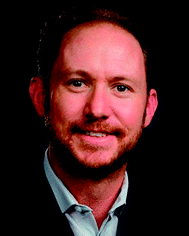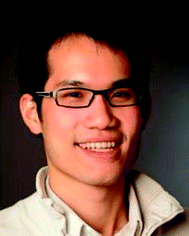DOI:
10.1039/C6TA90084D
(Profile)
J. Mater. Chem. A, 2016,
4, 6670-6679
Profile: Emerging Investigators 2016: novel design strategies for new functional materials
Andriy Zakutayev is a scientist at the National Renewable Energy Laboratory (USA) working on materials research and device development for novel solar energy conversion and other technologies, using high-throughput combinatorial experimental methods. Dr Zakutayev has a Ph.D. in Physics from Oregon State University, where he worked on wide-bandgap p-type semiconductors for transparent electronics. Andriy received his B.S. in Electronics from Lviv Polytechnic National University in Ukraine.
Atsushi Urakawa has been a Group Leader at the Institute of Chemical Research of Catalonia (ICIQ), Tarragona, Spain since 2010. He obtained his B.Sc. degree in Applied Chemistry at Kyushu University (Japan) including a one-year stay in the USA. Afterwards, he continued his education in Chemical Engineering at Delft University of Technology (The Netherlands) for MSc study and further at ETH Zurich (Switzerland) for Ph.D. study. Prior to his appointment at ICIQ, he was an Oberassistent (Senior Scientist/Lecturer) at the ETH Zurich. His research interests are centered on the development of heterogeneous catalysts and processes based on rational understanding aided by
in situ and
in operando spectroscopic methods, especially for CO
2 conversion reactions.
Candace Chan is an Assistant Professor in the materials science and engineering program in the School for Engineering of Matter, Transport and Energy at Arizona State University (ASU). Prior to joining ASU in 2011, she was a Miller Postdoctoral Fellow at the University of California, Berkeley in the Department of Chemistry. She received her Ph.D. in chemistry from Stanford University in 2009. As a graduate student, she was an NSF Graduate Fellow, Stanford Graduate Fellow, and winner of the MRS Graduate Student Award (Silver) and TMS Ross N. Tucker Award in Electronic Materials. She received a B.S. in chemistry from Rice University in 2005. Her research group is designing and studying the unique properties of nanostructured materials for applications in electrochemical energy storage, photocatalysis, and water treatment.
Cristina Tealdi is currently Assistant Professor at the Department of Chemistry of the University of Pavia, Italy, where she received her Ph.D. in Chemistry in 2006. During her postdoctoral years she was awarded an Alexander von Humboldt fellowship to work at the Technical University in Munich, Germany, and in 2013 she was the recipient of a “Future in Research” grant (FIRB) from the Italian Ministry for Education, University and Research. Her work is focussed on the investigation of materials for clean energy applications (
i.e. fuel cells and batteries) through the use of computational as well as experimental techniques, with emphasis on the role of structure and defects in tailoring materials performances.
Da Deng is an assistant professor of Chemical Engineering and Materials Science at the Wayne State University. He received his undergraduate training in Environmental Engineering at the National University of Singapore (NUS). After graduation, he worked as a research engineer in Chemistry at NUS for one year before he enrolled in a Ph.D. program in Chemical and Biomolecular Engineering in the same university. His Ph.D. dissertation was awarded the World Future Foundation (WFF) Ph.D. Prize in Environmental and Sustainability Research. His received his first postdoctoral training in Harvard University and second postdoctoral training in MIT. He joined the Wayne State University as a faculty member in 2011. His research interests mainly focus on green materials for energy and environmental applications, particularly those involving sustainable bio-inspired and bio-derived functional materials synthesized with low overall environmental footprint.
Francesco Bonaccorso gained his Ph.D. from the University of Messina, Italy after working at the Italian National Research Council, the Engineering Department of Cambridge University (UK) and the Department of Physics and Astronomy of Vanderbilt University (USA). In June 2009 he was awarded a Royal Society Newton International Fellowship at Cambridge University, and elected to a Research Fellowship at Hughes Hall, Cambridge, where he also obtained an MA. He is currently leading the processing and prototyping group at the Istituto Italiano di Tecnologia, Graphene Labs. He was responsible for defining the ten years scientific and technological roadmap for the European Graphene Flagship. His research interests encompass both the fundamental understanding and solution processing of novel nanomaterials with on-demand designed structures, their spectroscopic characterization, incorporation into polymer composites and their technological application in solar cells, lithium-ion batteries, light emitting devices and ultrafast lasers. He organized several conferences including Graphene2015/2016, Graphene Canada, GrapChina 2014/2015 and symposia in MRS, e-MRS. He is currently an Associate Editor of
RSC Advances.
Mark D. Symes was born in London in 1982 and graduated from the University of Cambridge in 2005. After a Ph.D. at the University of Edinburgh with David A. Leigh (FRS), he undertook postdoctoral studies at the Massachusetts Institute of Technology (2009–2010). In late 2010, he returned to the UK and became a postdoctoral researcher at the University of Glasgow. This didn't put them off though, and he joined the faculty at Glasgow in 2013. His research interests span energy conversion, small molecule activations, electrochemistry and coordination chemistry, as well as new materials for all the above.
Dr Jian Lin has been an assistant professor of Mechanical & Aerospace Engineering at University of Missouri (MU) since August, 2014. Prior to MU, he was a postdoctoral research associate in the Department of Mechanical Engineering and Materials Science (now Materials Science & Nanoengineering) at Rice University from 2011 to 2014. He got a B.S. in Mechanical and Automation Engineering from Zhejiang University in 2007. Then he studied at University of California-Riverside and received his M.S. in Electrical Engineering and Ph.D. in Mechanical Engineering in 2010 and 2011, respectively. Dr Lin's research centres on advanced materials synthesis and processing for applications in energy storage/conversion and electronics through both computational and experimental approaches. So far, he has published >30 peer-reviewed journal papers in the areas of energy, electronics and nanomaterials. He holds 4 issued and pending US patents. He has been an invited reviewer for 13 scientific journals. His work in electronics and energy storage has been featured in NSF, ACS, and Air Force Research Lab websites, and widely reported by the main scientific media such as C&EN, Science Daily, Manufacturing Engineering Magazine, Phys.org, IEEE Spectrum,
etc.
Julian Dean is a senior lecturer within the Department of Materials Science and Engineering at the University of Sheffield. His research is strongly linked to experimental analysis and atomic scale simulations to provide verification and realistic input parameters in order to predict optimised device performance. Using an in-house developed finite element (FE) package for solving Maxwell's equations in space and time, predictions of the impedance response, current density and electric field of a heterogeneous granular material can be made allowing him to begin linking the physical microstructure to the electrical microstructure. This work is supported by the development of a package capable of designing multigrain structures. This can generate models that incorporate realistic features such as variable grain size and shape, graded material properties, core–shell microstructures, grain boundaries, porosity and interfacial roughness.
Timothy Kelly is currently an Assistant Professor in the Department of Chemistry at the University of Saskatchewan, and holds a Tier 2 Canada Research Chair in Photovoltaics. He received his B.Sc. degree in Chemistry from the Memorial University of Newfoundland in 2005 and went on to complete his Ph.D. under the supervision of Prof. Michael Wolf (2005–2009) at the University of British Columbia. From 2009–2011 he was an NSERC Postdoctoral Fellow in the laboratory of Prof. Michael Sailor at the University of California, San Diego. In 2011 he began his independent academic career at the University of Saskatchewan in Saskatoon, Canada. His research interests include perovskite solar cells, hard X-ray scattering techniques, organic photovoltaic devices, and the optoelectronic applications of plasmonic nanoparticles.
Marleen Kamperman is an Assistant Professor at the Physical Chemistry and Soft Matter Laboratory at Wageningen University, the Netherlands. Her research focuses on the biologically inspired synthesis of polymers and nanostructured surfaces with controlled adhesive properties. She received her Ph.D. in Materials Science & Engineering from Cornell University, Ithaca, NY, where she worked in the group of Prof Ulrich Wiesner. From 2008 to 2010, she was a postdoctoral researcher in the Functional Surfaces group of Prof Eduard Arzt at INM – Leibniz Institute for New Materials in Saarbrücken, Germany. In 2014, she was a visiting professor in the Soft Matter Sciences and Engineering Laboratory at ESPCI ParisTech, Paris, France. To establish her own research group she received a NWO-VENI grant (2010), an Athena premium (2012) and a NWO-VIDI grant (2014). In 2015, she became a member of the Dutch Young Academy.
Nicolas Vogel studied chemistry at the Johannes Gutenberg-University in Mainz, Germany and Seoul National University in Seoul, Republic of Korea. In 2011, he received his Ph.D. working with Katharina Landfester at the Max Planck Institute for Polymer Research in Mainz. He joined the group of Joanna Aizenberg at the School of Engineering and Applied Sciences at Harvard University as a postdoctoral fellow. In 2014, he was appointed associate professor in the Department of Chemical and Biological Engineering at the Friedrich-Alexander-University Erlangen-Nuremberg. He likes to understand how colloidal particles assemble and to see functional properties emerge entirely from controlling the structure of such self-assembled systems. When not in the lab, he prefers to be outdoors.
Robert G Palgrave studied for his undergraduate and Ph.D. degrees in the Chemistry Department, University College London. His doctoral work under Prof. Ivan Parkin was on chemical deposition of thin films of nanoparticles. In his postdoctoral work he moved to physical vapour deposition techniques – first working on molecular beam epitaxy of oxides at Oxford with Prof. Russ Egdell, then on pulsed laser deposition of artificial layered structures with Prof. Matthew Rosseinsky. He returned to UCL to take up a lectureship in 2012, and now leads a group which has diversified away from thin film deposition into general solid state chemistry and a number of other areas – ionic liquids, biocompatible polymers, photocatalysts and carbon nitride.
Rodney D. Priestley is an Associate Professor in the Department of Chemical and Biological Engineering at Princeton University. He obtained his Ph.D. in Chemical Engineering from Northwestern University in 2008. He completed a NSF/Chateaubriand postdoctoral fellowship at Ecole Superieure de Physique et Chimie Industrielles de la Ville de Paris. His research interests include polymer glasses, nanoconfined polymer dynamics, polymer thin film and nanoparticle formation, MAPLE and responsive polymers. He is the recipient of numerous awards including the Quadrant Award, ACS New Investigator Grant, 3M Non-Tenured Faculty Grant, NSF CAREER Award, AFOSR YIP, Presidential Early Career Award for Scientist and Engineers, Alfred P. Sloan Fellowship and Camille Dreyfus Teacher-Scholar Award. Most recently he was named to The Root 100 list of most influential African American in 2014.
Rui Liu received his Ph.D. in chemistry from University of California, Riverside in 2010. He carried out his first postdoctoral research at Oak Ridge National Laboratory. In 2012–2015, he was a postdoctoral associate in the laboratory of Professor Rodney Priestley at Princeton University. In 2015, he joined Tongji University as a Young Thousand Talented professor. His research interests include nanoparticle preparation and polymer self-assembly.
Dr Sara Skrabalak received her B.A. degree in chemistry from Washington University in St. Louis in 2002 where she conducted research with Professor William E. Buhro. She was the recipient of the Sowden Award in undergraduate research from the Department of Chemistry. She then moved to the University of Illinois at Urbana-Champaign where she completed her Ph.D. degree in chemistry in fall of 2006 under the tutelage of Professor Kenneth S. Suslick. There, she was the recipient of the T.S. Piper Thesis Award for her work on porous materials. She then conducted postdoctoral research at the University of Washington – Seattle with Professors Younan Xia and Xingde Li, designing nanomaterials for biomedical applications. She is the James H. Rudy Associate Professor of Chemistry at Indiana University – Bloomington and a recipient of both NSF CAREER and DOE Early Career Awards. She is a 2012 Research Corporation Cottrell Scholar, a 2013 Sloan Research Fellow, a 2014 Camille Dreyfus Teacher-Scholar, and recipient of the 2014 ACS Award in Pure Chemistry and 2015 Baekeland Award. Her research group focuses on nanomaterial design and synthesis.
Dr Vivek Polshettiwar is a reader at TIFR, Mumbai. Before joining TIFR, he worked at ENSC, Montpellier, France; US-EPA, Cincinnati and KAUST. He has published more than 80 articles in top journals and has an h-index of 39 and more than 5000 citations. Several of his articles are rated as Top 10, Top 5, Hot articles and appear on journal front covers. He is the recipient of several awards, such as the prestigious Oak Ridge Institute for Science and Education (ORISE) Research Fellowship, Asian Rising Star award at 15th Asian Chemical Congress (ACC),
etc. Recently, he was admitted as a Fellow of the Royal Society of Chemistry (RSC), United Kingdom and has also been recognized as one of the 175 Faces of Chemistry. His research interests are in the area of advanced nano-materials, nanocatalysis and green chemistry. He believes that next generation catalysts can be developed by shape and morphological control of nano-materials which will allow preferential exposure of active sites.
Yabing Qi is currently an Assistant Professor and Head of Energy Materials and Surface Science Unit (EMSS) in Okinawa Institute of Science and Technology Graduate University (OIST). Dr Qi received his BS, MPhil, and Ph.D. degrees from Nanjing University, Hong Kong University of Science and Technology, and University of California Berkeley, respectively. His research interests include perovskite solar cells, organic electronics, surface sciences, energy materials and devices. Dr Qi has co-authored ∼50 peer-reviewed papers and has delivered 70+ invited and contributed research presentations at international conferences, technical meetings and universities.
Yuekun Lai received his Ph.D. degree from the Department of Chemistry, Xiamen University. During 2009–2011, he worked as a research fellow at Nanyang Technological University, Singapore. In July of 2011, he moved to Muenster University with Prof. Harald Fuchs and Prof. Lifeng Chi under the support of Humboldt Scholarship of Germany. He is currently a professor at National Engineering Laboratory for Modern Silk, and School of Textile and Clothing Engineering in Soochow University since 2013. His research interests are focused on TiO
2 nanostructures, bio-inspired intelligent surfaces with special wettability, energy and environmental materials.
Yun Hau Ng received his Ph.D. from Osaka University in 2009. After a brief research visit to the Radiation Laboratory at University of Notre Dame (Prof. Prashant Kamat's group), he joined the ARC Centre of Excellence for Functional Nanomaterials led by Prof. Rose Amal at UNSW with the Australian Postdoctoral Fellowship (APD) in 2011. He is currently a lecturer in the School of Chemical Engineering at UNSW. His research is focused on the development of novel photoactive semiconductors (particles and thin film) for sunlight energy conversion. He received the Honda-Fujishima Prize in 2013 in recognition of his work in the area of photo-driven water splitting. He has published over 60 peer-reviewed research articles.
Dr Zijian Zheng's research interests include surface and polymer science, nanolithography, flexible/stretchable/wearable/graphene materials and electronic devices. He received a BEng in Chemical Engineering at Tsinghua University in 2003, and Ph.D. in Chemistry at University of Cambridge in 2007 (under the supervision of Prof. Wilhelm T. S. Huck). In 2008, Dr Zheng joined the group of Prof. Chad A. Mirkin as a postdoctoral research fellow in the Department of Chemistry and International Institute for Nanotechnology at Northwestern University, working on the development of dip-pen nanolithography and polymer pen lithography. He joined the Hong Kong Polytechnic University as Assistant Professor in 2009 and was promoted to tenured Associate Professor
via a fast track. Dr Zheng has published >60 papers in high-impact international scientific journals.
Ross Forgan is a Royal Society University Research Fellow in the School of Chemistry at the University of Glasgow. After receiving MChem (Hons) and Ph.D. degrees from the University of Edinburgh in 2004 and 2008, under the supervision of Prof. Peter Tasker, he spent three years as a postdoctoral researcher in the group of Prof. Sir J. Fraser Stoddart at Northwestern University, USA. In 2011 he returned to Scotland as a postdoctoral researcher in the group of Prof. Lee Cronin at the University of Glasgow, and took up his current independent position in 2012. His research group is interested in the crystallisation and functionalisation of MOFs, as well as their materials properties and biomimetic applications.
Timothy Easun is a Royal Society University Research Fellow in the School of Chemistry at Cardiff University. Timothy received his MSci in Chemistry from Nottingham University and, after a year out of academia, completed a Ph.D. in Supramolecular Photochemistry with Michael D. Ward at the University of Sheffield. He then returned to Nottingham to undertake postdoctoral research with Mike George, combining photocrystallography with time-resolved spectroscopies. Briefly holding a Teaching Fellow post, Timothy took on the role of Senior Research Officer for Martin Schröder, also at Nottingham, supervising a large and highly active porous materials research group. Moving to Cardiff in April 2015 to take up an independent Cardiff University Research Fellowship, his research is concerned with the control of nanoscale flow of molecules within porous materials using photochemistry as both probe and actuator to make nanofluidic devices. His group designs, synthesises and characterises photoactive porous metal-organic frameworks.
Xiaoxin Zou was awarded a Ph.D. in Inorganic Chemistry from Jilin University (China) in June 2011, and then moved to the University of California, Riverside and then Rutgers, The State University of New Jersey as a Postdoctoral Scholar from July 2011 to October 2013. He has been an associate professor in Jilin University since December 2013. His research interests focus on the design and synthesis of noble metal-free, nanostructured materials for water splitting and renewable energy conversion.
Osman M. Bakr holds a B.Sc. in Materials Science and Engineering from MIT (2003) as well as a M.S. and Ph.D. in Applied Physics from Harvard University (2009). He is currently an Associate Professor of Materials Science and Engineering, SABIC Presidential Career Development Chair, at KAUST, Saudi Arabia. His research group focuses on the study of hybrid organic–inorganic nanoparticles and materials; particularly advancing their synthesis and self-assembly for applications in photovoltaics and optoelectronics.
Bin Liu received his B.Eng. (1st Class Honors) and M.Eng. degrees in Chemical Engineering from the National University of Singapore, and obtained his Ph.D. degree in Chemical Engineering from University of Minnesota in 2011. Thereafter, he moved to University of California, Berkeley and worked as a postdoctoral researcher in the Department of Chemistry during 2011–2012 before joining the School of Chemical and Biomedical Engineering at Nanyang Technological University as an Assistant Professor in 2012. His main research interests are electrocatalysis, photovoltaics and photoelectrochemistry.
Wilson A. Smith is an Assistant Professor in the Department of Chemical Engineering at Delft University of Technology. He earned his BS in Physics from American University in 2005, and his Ph.D. in Physics from the University of Georgia in 2010, where he studied the synthesis and applications of nanostructured photocatalysts. From there he moved to Paris, France as a postdoctoral research associate at the Universite Pierre et Marie Curie/Sorbonne where he studied the defect structure of doped semiconductors for solar water purification. In 2012 he began his current position at TU Delft, where his group focuses on fundamental processes related to photoelectrochemical water splitting, electrocatalytic water oxidation, and CO2 reduction catalysis using inorganic nanostructured materials. A specific focus is placed on studying only earth abundant materials, and using in situ techniques to probe the material properties and reaction processes during (photo)electrochemical testing.
Vincent Tung is an Assistant Professor at the nascent University of California, Merced and is affiliated with the Molecular Foundry, Lawrence Berkeley National lab. He received his Ph.D. degree in materials science and chemistry from the University of California, Los Angeles in 2009 and became an Initiative for Sustainability and Energy at Northwestern (ISEN) postdoctoral research fellow at the Northwestern University in 2010. His main research interest is in the general area of materials chemistry and assembly of functional nanomaterials for energy harvesting and storage. He is the recipient of an America Chemical Society Petroleum Fund New Doctoral Investigator Award, and the Research Excellence Early Career Investigator Award by the Graduate Council at the University of California. He is also a die-hard fan of the Red Sox and enjoys a cup of coffee at Blue Bottle and Sight glass.
Brent C. Melot received his Ph.D. from the Materials Department at the University of California, Santa Barbara under the supervision of Ram Seshadri. His research at UCSB focused on understanding the relationship between the atomic structure and magnetic properties of complex oxides. After completing his doctoral work (2010), Brent joined the Laboratoire de Réactivité et Chimie des Solides in Amiens as a postdoctoral research associate under Jean-Marie Tarascon. Since 2012, he has been an Assistant Professor in the Department of Chemistry at the University of Southern California in Los Angeles where his group continues to develop a deeper understanding of how the crystal structure and composition of materials influence their functional properties.
Marek Grzelczak found his passion for chemistry while doing research as an undergraduate at Helmholtz-Zentrum Berlin (Germany). After receiving his BS at University of Adam Mickiewicz in Poznan (Poland), he pursued doctoral studies with Professor Luis M. Liz-Marzán at University of Vigo (Spain), where he received his Ph.D. in 2008. He then conducted postdoctoral research at the University of Trieste (Italy) with Professor Maurizio Prato and later at Max-Planck Institut with Professor Markus Antonietti. In 2012 he joined CIC biomaGUNE in San Sebastian as a Ikerbasque Research Fellow. His work at CIC biomaGUNE focuses on the self-assembly of particles for plasmonic nanochemistry.
Shane Ardo has been an Assistant Professor at the University of California, Irvine in the Department of Chemistry since 2013 and holds a joint appointment in the Department of Chemical Engineering and Materials Science. He obtained a BS Degree in Mathematics in 1999 from Towson University and was a goalkeeper for their Division I-A Men's Soccer team. He worked as an IT Consultant for one year before deciding to become a teacher at the Community College of Baltimore County (CCBC) and then at Baltimore City College High School. His science career began at CCBC where he took Organic Chemistry as a part-time evening student. After that he obtained an MS Degree in Nutrition in 2005 from the University of Maryland followed by a Ph.D. Degree in Photo-Physical Inorganic Chemistry in 2010 from Johns Hopkins University. Then he worked as a DOE-EERE Postdoctoral Research Awardee at the California Institute of Technology until 2013. Prof. Ardo's research interests are driven by the pursuit of understanding and controlling energy conversion mechanisms for applications in solar fuels devices, photovoltaics, seawater desalination, and redox flow batteries.
Dr Joel van Embden is a Senior Lecturer and ARC Research Fellow in the School of Science at RMIT University. He received his Ph.D. from The University of Melbourne in 2008 for work on the synthesis and nucleation kinetics of nanocrystals under the mentorship of Professor Paul Mulvaney. His research interests include the synthesis of novel nanomaterials, the kinetics and thermodynamics of nanoparticle formation, colloid surface chemistry, quantum dot composite materials, and nanostructured thin films for optoelectronics and energy harvesting applications. At present, his major research focus is on the fabrication and characterization of novel solution processed inorganic solar cells.
Manuel Tsotsalas was born in Düsseldorf, Germany and obtained his diploma degree in Chemistry in 2006 at the University of Münster where he then attended the International NRW Graduate School of Chemistry and earned his Ph.D. under the guidance of Prof. Luisa De Cola in 2010. After completing his Ph.D., he was a DAAD postdoctoral fellow in the laboratory of Prof. Susumu Kitagawa/group of Prof. Shuhei Furukawa at Kyoto University, Japan. After his postdoctoral research, he joined the Karlsruhe Institute of Technology, where he is currently an independent group leader at the Institute of Functional Interfaces (IFG) and at the Institute of Organic Chemistry (IOC). He is PI in the SFB 1176, molecular structuring of soft matter and leader of the Helmholtz Young Research Group, hierarchically structured biomaterials. His research interests centre around the synthesis, processing and application of porous organic/metal-organic frameworks.
Maksym Kovalenko has been a tenure-track Assistant Professor of Inorganic Chemistry at ETH Zürich since July 2011 (Zürich, Switzerland). His group is also partially hosted by Empa (Swiss Federal Laboratories for Materials Science and Technology, Dübendorf, Switzerland) to support his highly interdisciplinary research program. Born and educated as a chemist in Ukraine, he completed doctoral studies at Johannes Kepler University Linz (Austria, 2004–2007, with Prof. Wolfgang Heiss), followed by postdoctoral training at the University of Chicago (USA, 2008–2011, with Prof. Dmitri Talapin). His present research aims to provide novel inorganic materials for photovoltaics and other optoelectronic applications, rechargeable lithium-ion batteries and post-lithium electrochemical storage devices. The portfolio of investigated materials includes colloidal quantum dots, lead halide and lead-free perovskite nanocrystals and single crystals, as well as metals, metal alloys, metal oxides, sulfides and fluorides. He is the recipient of an ERC Starting Grant 2012, Ruzicka Prize 2013 and Werner Prize 2016.
Yun Jung Lee is assistant professor at Hanyang University. She earned her B.S. and M.S. degrees from Seoul National University. She received her Ph.D. degree in Department of Materials Science and Engineering at Massachusetts Institute of Technology in 2009. Upon completion of her Ph.D., she worked as a postdoctoral fellow in the Materials Sciences Group at Pacific Northwest National Laboratory. In 2011, she joined Hanyang University and her research focuses on advanced nanomaterials design for energy conversion and storage devices. Her research also includes bio-inspired nanochannel design for energy harvesting and water treatment.
Meidan Ye is an associate Professor in the Research Institute for Soft Matter and Biomimetics, Department of Physics, College of Physical Science and Technology at Xiamen University. She received her Ph.D. in Physical Chemistry from the State Key Laboratory of Physical Chemistry of Solid Surfaces, and College of Chemistry and Chemical Engineering at Xiamen University in 2014. Her research interests include advanced nanostructured materials (
e.g., TiO
2, ZnO, Cu
xS, CoS, SrTiO
3,
etc.) for energy and environment applications, such as perovskite solar cells, dye/quantum dot-sensitized solar cells, hydrogen production from photoelectrocatalytic water splitting, photocatalytic degradation of organic pollutants, and electrochromic devices.
Yu-Lun Chueh received his Ph.D. degree from the Department of Materials Science and Engineering, National Tsing Hua University, Taiwan in 2006 and worked as a postdoctoral researcher in electrical engineering and computer science, UC Berkeley from 2007 to 2009. He joined the Department of Materials Science and Engineering, National Tsing Hua University in 2009; currently, he is a professor in the same department. He has published 211 peer-reviewed papers and 19 patents with total citations >6000 and a h-index of 37. His research directions include: development of Cu(In,Ga)Se
2 solar cell and its light harvesting behavior, growth of low-dimensional materials and their possible functional applications, low power resistive random access memory, development of various methods to synthesize different graphene/two-dimensional materials and development of electrically charged-induced selective ions in porous nanostructures and their application in the desalination of saline water.
Debasish Haldar received his postgraduate degree in Chemistry from University of Calcutta, Kolkata, India, in 1999 and later his Ph.D. degree from Jadavpur University, Kolkata, India, in 2005 under the supervision of Professor Arindam Banerjee, IACS, Kolkata. After postdoctoral studies with Professor Ivan Huc at IECB in France, Professor Aline Miller at the University of Manchester in UK and Professor Carsten Schmuck at the University of Würzburg in Germany, he joined the Indian Institute of Science Education and Research Kolkata in 2008 as Assistant Professor. He was made Associate Professor in 2013. His research interests include developing designer amino acids and analogues, peptides, foldamers and related materials. He has published over 70 papers, 5 book chapters and 2 books.
Stephen Sproules obtained a Ph.D. from the University of Melbourne, which included collaborations with the Universities of Nottingham and Saskatchewan, and the Stanford Synchrotron Radiation Laboratory. His postdoctoral work focused on combining experiment and theory to elucidate the electronic structures of transition metal complexes with radical ligands at the then Max Planck Institute for Bioinorganic Chemistry with Karl Wieghardt. This was followed by a posting at the EPSRC National EPR facility at The University of Manchester. In 2013, he began his current position as lecturer at the University of Glasgow. Stephen's research focuses on the development of radical ligand complexes for a variety of magnetic and spintronic applications, as well as applying EPR spectroscopy to energy materials, bioinorganic systems, heterogeneous catalysis and chemical sensing.
Abhishek Dey was born in Calcutta where he did his B.Sc in the Presidency College. After completing his M.Sc. at the Indian Institute of Technology, Kanpur, he did his Ph.D. at Stanford University, CA, USA, in 2007 with Prof. Edward I. Solomon. After two years of postdoctoral work with Prof. James P. Collman he joined IACS in June 2009 where he is now an Associate Professor. He is the recipient of ACS division of inorganic chemistry young investigator award, SPP Young investigator award and he has been young associate of the Indian Academy of Science, Bangalore. He is currently serving as editorial advisory board member to
Inorganic Chemistry,
Chemical Communications,
ACS Catalysis and
Journal of Biological Inorganic Chemistry. He is an inorganic chemist interested in generation, storage and transfer of energy. A combination of synthesis, self-assembly, spectroscopy, electrochemistry and electronic structure calculations are used to attain these research goals.
Mike Rose is an Assistant Professor in the Chemistry Department at the University of Texas at Austin. He received his Ph.D. from UC Santa Cruz in 2009 (Advisor: Prof Pradip Mascharak) in synthetic bio-inorganic chemistry, and went on to a postdoctoral position at Caltech co-advised by Prof Harry Gray and Prof Nate Lewis under the auspices of the CCI-Solar multi-investigator program. At Caltech, Mike merged his interest in synthetic inorganic chemistry with semiconductor photoelectrochemistry and surface chemistry. In his independent career at UT, Mike has developed a hybrid molecular/materials approach to the functionalization of silicon with organic linkers and materials or molecular catalysts (MoS
2, Pt, PNP-Ni chelates,
etc.). Other projects include the synthesis and function of biomimetic models of [Fe]-hydrogenase, as well as the study of late transition metal complexes derived from heavy main group elements (Sb, Bi).
Jin Suntivich is an assistant professor in the Department of Materials Science and Engineering at Cornell University. After receiving bachelor degrees from Northwestern University, IL, USA, he went to obtain his doctoral degree in Materials Science and Engineering at the Massachusetts Institute of Technology (MIT), MA, USA, where he studied precious metal and transition oxide electrocatalysts for electrochemical energy conversion reactions. After completing his doctoral degree, Jin conducted a postdoctoral fellowship at Harvard University, MA, USA, where he studied transient spectroscopy and photochemistry of titanium dioxides. In fall 2013, he began his Assistant Professor position at Cornell. His current research focuses on connecting electrochemical properties with fundamental structure–property relationships in oxides through the use of well-defined surfaces and optical spectroscopy.
|
| This journal is © The Royal Society of Chemistry 2016 |
Click here to see how this site uses Cookies. View our privacy policy here. 
